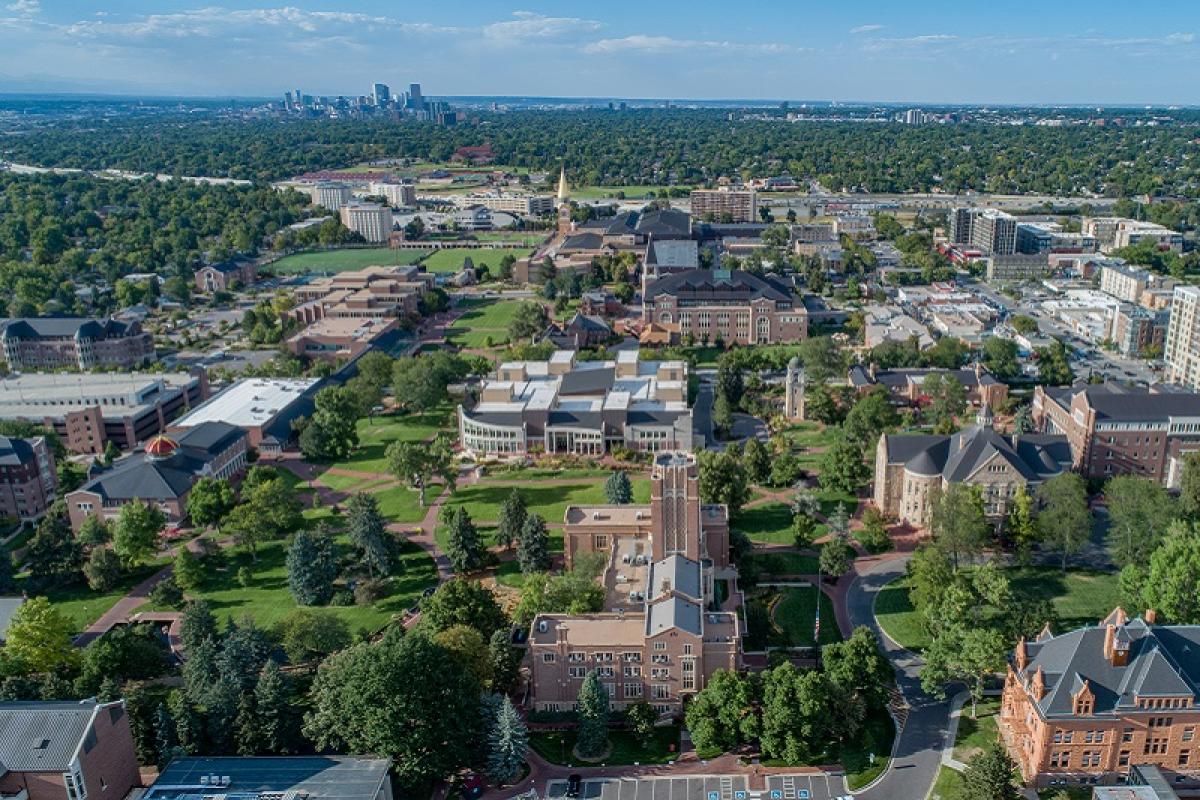DU Field Notes: The Stories Behind DU’s Buildings

The University of Denver’s red-brick walkways weave together an intriguing tale, with each offshoot offering a small chapter in DU’s 156-year lifetime. Each building on campus has a story tell — about the growth of the city, the expansion of the school and the evolution of the college experience.
With the help of “Built for Learning,” a 2008 book showcasing DU’s architectural personality, the Newsroom takes a tour of some of the campus’ most distinctive — and most fascinating — structures.
University Hall

When workers broke ground on University Hall, they laid the cornerstone for the DU we know today. Before 1890, DU’s headquarters sat in downtown Denver, at the intersection of 14th and Arapahoe. University Hall, made of lava stone from nearby Castle Rock, served as the flagship building on what was then known as the University Park campus. DU certainly made the most of its new, four-story space, which at first housed: the chancellor’s office, two reception rooms, a chapel, two recital rooms, the library, Evans Literary Club, Phi Alpha Society, the school newspaper, business offices, a chemistry lab, the girls’ gymnasium and space for a future museum.
Mary Reed Building
Not to be confused with the building across campus that honors her daughter, the collegiate gothic Mary Reed Building memorializes one of DU’s most prominent early philanthropists. Mary Reed originally replaced the Carnegie Library in 1933, boasting increased capacity and capable of shelving 400,000 volumes. It is specifically designed in an H pattern, allowing natural light to shine in from the north, south and west. When Reed died in 1945, she willed most of her library to DU and stipulated that her 1923 portrait hang inside. (You can still view it above the fireplace in the second-floor Renaissance Room.) More than a few people contend that her spirit remains inside the building, haunting the halls and spooking staff and students alike.
The Ritchie Center for Sports & Wellness

The iconic gold tower, long associated with DU, wasn’t part of the plan when architects drew up blueprints for the Ritchie Center. The idea was a relatively late addition from namesake and then-Chancellor Dan Ritchie, who wanted a tower that could be illuminated when the Pioneers won a hockey game, broadcasting the good news to the entire city. At 192 feet tall, the gold-topped Carl M. Williams bell tower features a narrow spiral staircase leading to a 65-bell carillon that plays free concerts throughout the year and hosts open houses where visitors can marvel at the massive bells and the breathtaking view. If you dare look down on your ascent, you will see four wall murals, charting the history of communication, from spoken word to digital tech.
Chamberlin Observatory
The 20-foot tall telescope in Chamberlin Observatory is so old, it predates electricity. But back in 1894, it was state of the art. Weighing in at 11 tons of cast iron, the building is the centerpiece of nearby Observatory Park. DU’s Department of Physics and Astronomy manages and cares for the 130-year-old observatory, which features a rotating dome that can open toward any part of the sky. DU’s first astronomy professor, Herbert Howe, modeled Chamberlin after the Carleton College Goodsell Observatory in Northfield, Minnesota.
Evans Chapel

Even with its 400 tons of stone and stained glass, the Evans Chapel, tucked into a pocket in the middle of campus, is easy to miss. The chapel originally was built in 1878 as a second site for the Grace Methodist Episcopal Church. DU founder John Evans funded it to honor his daughter, Josephine, who had died a decade earlier. When DU purchased the property in 1958, administrators considered demolishing it to create a parking lot. Instead, they made the decision to dismantle the building by hand, stone by stone, and number the pieces for reassembly. Today, the nondenominational chapel hosts weddings, meditation, personal prayer, baptisms and more.
Chambers Center

Few buildings embody their purpose as well as the Merle Catherine Chambers Center for the Advancement of Women, which houses the Colorado Women’s College. The Chambers Center, which opened in 2004, was designed, funded and built by women. Inspiration for the building’s signature motif came from a ceramic dish belonging to Mike Bloom, the dean of the women’s college, featuring a nautilus shell, representing a lifetime of growth. Today, you can see the nautilus design in the building’s front window, the common room furniture, the winding staircase and on copper plates outside offices. Architect Jane Loefgren also looked to the Church of San Spirito in Florence, Italy, for ideas, which is why the classrooms on the first and second floor are in the shape of a cross.
Dimond Family Residential Village

One of the University’s newest buildings, the Dimond Family Residential Village opened its doors this fall, welcoming first-year students to an entirely new collegiate living experience. A product of the DU IMPACT 2025 strategic plan, Dimond is all about community. More than 500 students can fill more than 250 rooms, which are divided into “houses” to support six cohorts of students. Dimond is also notable for its sustainability — the building is on track for LEED Gold certification, thanks to its rooftop solar panels. What’s more, the building was brought to life by a number of minority-, women- and veteran-owned businesses, as well as small businesses, which, together, made up 35% of all business participation in the construction process.












